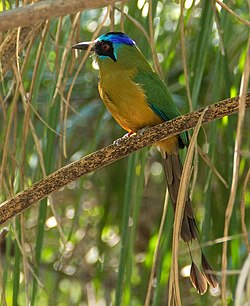Motmots
| Common name | Scientific name and subspecies | Range | IUCN status and estimated population |
|---|---|---|---|
| Tody motmot | H. momotula Lichtenstein, M. H. C., 1839 Three subspecies
| Southern Mexico to northwestern Colombia | LC
|
| Common name | Scientific name and subspecies | Range | IUCN status and estimated population |
|---|---|---|---|
| Blue-throated motmot | A. gularis (Lafresnaye, 1840) | Southern Mexico to Honduras | LC
|
| Common name | Scientific name and subspecies | Range | IUCN status and estimated population |
|---|---|---|---|
| Russet-crowned motmot | M. mexicanus Swainson, 1827 Four subspecies
| Northwestern Mexico to southwestern Guatemala | LC
|
| Blue-capped motmot | M. coeruliceps (Gould, 1836) | Northeastern Mexico | LC
|
| Lesson's motmot | M. lessonii Lesson, R. P., 1842 Three subspecies
| Southern Mexico to western Panama | LC
|
| Whooping motmot | M. subrufescens Sclater, P. L., 1853 Four subspecies
| Central and South America | LC
|
| Trinidad motmot | M. bahamensis (Swainson, 1838) | Trinidad and Tobago | LC
|
| Amazonian motmot | M. momota (Linnaeus, 1766) Nine subspecies
| Amazon rainforest  | LC
|
| Andean motmot | M. aequatorialis Gould, 1858 Two subspecies
| Andes  | LC
|
| Common name | Scientific name and subspecies | Range | IUCN status and estimated population |
|---|---|---|---|
| Rufous motmot | B. martii (Spix, 1824) Two subspecies
| Central and South America | LC
|
| Rufous-capped motmot | B. ruficapillus (Vieillot, 1818) | Southeastern Brazil, eastern Paraguay and northeastern Argentina | LC
|
| Common name | Scientific name and subspecies | Range | IUCN status and estimated population |
|---|---|---|---|
| Keel-billed motmot | E. carinatum (du Bus de Gisignies, 1847) | Southern Mexico to northern Costa Rica | VU
|
| Broad-billed motmot | E. platyrhynchum (Leadbeater, 1829) Six subspecies
| Central and South America | LC
|
| Common name | Scientific name and subspecies | Range | IUCN status and estimated population |
|---|---|---|---|
| Turquoise-browed motmot | E. superciliosa (Sandbach, 1837) Seven subspecies
| Southern Mexico to northwestern Costa Rica | LC
|













